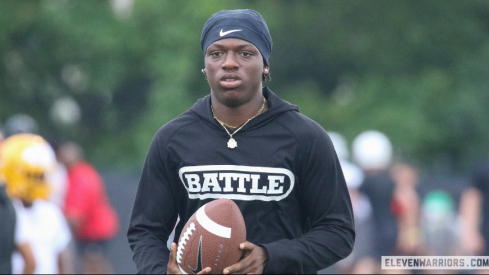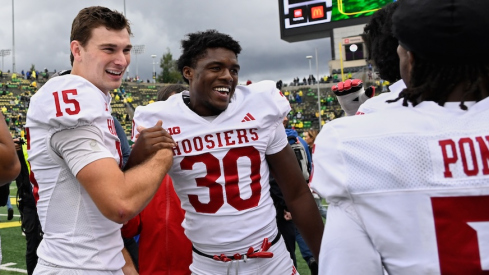
The Ohio State defense turned in a vintage performance against Wisconsin in bending but not breaking to hold the Badgers to 14 points. Wisconsin came out with a solid game plan that utilized unbalanced lines and shifts to confuse the Buckeye gap control and leverage.
OSU hung tough, however, mixing and matching coverage schemes to employ an extra defender in the box. Crucially, OSU did not 'break' as they had earlier this season because they maintained leverage and had stable safety support. The Buckeyes were able to rely upon the improved play of key cogs of the Buckeye defense to make plays when needed, sealing the victory.
Numbers and the Centerline
The Wisconsin offensive coaches unveiled an admirable game plan. Wisconsin employed unbalanced lines and motion to challenge the Buckeyes' gap control and numbers response. Each side has eleven players. The offense controls how many offenders they employ to each side of the center line.
A defense must respond by matching those numbers. The Badger offense attempted to exploit this principle by using shifts and unbalance to confuse the Buckeye keys and recognition. Defenders are often not used to correctly counting gaps and receivers with unbalanced lines because they do not often see them. For instance, here Wisconsin goes unbalanced left and then uses fly motion right to confuse how the Buckeye secondary leverages run plays.
The Badgers also repeatedly shifted both their tight end and H-back to the boundary. They would then run inside zone to the field.
Wisconsin's goal was likely the following. OSU puts their under front to the field. That means that the 3 technique Johnathan Hankins and weak end Nathan Williams play to the boundary. Wisconsin's goal appeared to be to stretch those two defenders towards the tight end, and then run away to the field, taking away OSU's backside support. The Badgers also always ensured they blocked Williams in some manner. If he was uncovered by a tight end they would run zone away and have the H-back block across the formation.
Wisconsin used these same unbalanced formations to set up play-action passes. Multiple play-action passes came from these unbalanced fronts. The likely goal again was to confuse the Buckeye back seven's man coverage principles.
By extensively using unbalanced and overload looks (seven offenders to one side of the center line), Wisconsin sought to manufacture opportunities to run its base offense without having to merely line up and defeat the Buckeye front four. The Badgers were also trying to set up the Buckeyes throughout the game. Wisconsin repeatedly shifted their tight end and H-back and ran inside zone to the field. In the fourth quarter, OSU began slanting towards the field. The Badgers then ran counter trey back towards the boundary from this same pre-snap look.
In so doing, Wisconsin created opportunities for its run game.
Two Can Play at This Game
The Buckeye defense was not without its responses to the Badger run game. OSU's goal throughout the contest was to apply an additional defender against the run game. OSU did so in two basic ways. The Buckeyes opened in run downs playing quite a bit of quarter-quarter-half coverage. This allowed OSU to use Bradley Roby as the boundary force defender.

The Buckeyes also featured heavy amounts of cover-1 robber, particularly when they wanted run support to the field. This brought CJ Barnett into the 'box.'
But OSU also played large amounts of cover-1 in pass downs. Here, Zach Boren is free to delayed blitz when the back he is responsible for stays in pass protection.
OSU's scheme also adapted as the game progressed. The Buckeyes increasingly played an old staple, cover-3, particularly on third down.
This allowed OSU to mix and match two single high safety looks that both brought Barnett down in run support.
The Buckeyes also looked to mix and match fronts. Since Wisconsin was attempting to run away from the boundary, OSU went to a 4-3 over to put Hankins to the field.
Slow Starting
For all of Wisconsin's ingenuity in their game plan they were able to successfully run the football, particularly in the first half, by often winning the battle between their interior three and the OSU inside tackles and linebackers. Wisconsin was able to get double team movement inside, which was exacerbated by the Buckeye linebackers' initial tepidness in coming downhill. The OSU linebackers were catching blocks downfield rather than filling the hole, allowing a good back like Montee Ball to pick through creases.
Even while the Badgers were running the football the Buckeyes were able to largely contain Wisconsin, however, because their secondary maintained run support and made tackles. Ball was not allowed to break free past the secondary. This was perhaps the biggest difference from the OSU defense's early season problems. While Ohio State certainly did not stop the Badgers' offense, they were able to stall them out because they did not give up explosive plays, particularly in the run game. This forced Wisconsin to drive the length of the field.
But Gettin' the Hang of It
In so doing, the defense gave itself the chance to make minimal and negative yardage plays. As soon as it put Wisconsin behind schedule OSU gained the advantage. The Buckeyes were able to do so primarily on Johnny Simon's back. Simon was injured earlier this season but was back to his expected explosive self on Saturday. The Wisconsin offensive tackles could not keep up with his first step, either in the run or pass game.
Simon's play allowed the other Buckeyes who have been so crucial to the OSU defense's improved play in the second half to step up and make plays. As noted, CJ Barnett and Christian Bryant are one such example. As Barnett has gotten healthier, the two are more soundly filling their roles at strong and free safety, respectively, with Barnett making plays downhill and Bryant maintaining sound leverage and tackling from center field. Etienne Sabino also had a strong return from injury. What was particularly noteworthy was that Sabino performed well at something he had not really had to do all year—play Sam linebacker against a run-first team and set the edge. Ryan Shazier, though, was perhaps the critical performer, particularly in the second half. Any initial tentativeness was gone as he started charging downhill to make plays. But more than that, what is so impressive is how well he is maintaining inside-out leverage at all times. The soundness of his technique is one of the biggest in-season improvements I have seen (the key to the play, though, is how well Bradley Roby maintains contain to allow Shazier to make the play).
Slow Learning...or Quick Turnaround
Unfortunately, after 59 minutes of slowing Wisconsin, Ohio State allowed Wisconsin to quickly score a last-minute touchdown. Though the defense was hurt by poor starting field position, they aided Wisconsin's drive through scheme choices. OSU largely employed their 30 front and played a cover-3, 5 under. As a result, and unlike much of the game, the Buckeyes did not apply pressure to Wisconsin's Curt Phillips. This allowed him to get comfortable and step into throws.
The Buckeyes were able to turn this around in overtime, however, by largely learning from their fourth quarter mistakes. The crucial play was likely OSU's stop of Wisconsin's third down run for negative gain. Wisconsin went back to the well, motioning their H-back strong and then running counter trey to the boundary. This time, OSU twisted their defensive tackles. Johnathan Hankins drove the playside guard into the backfield, rendering the play stillborn.
Then on fourth down, OSU did not make the same mistake regarding pressuring Phillips. The Buckeyes brought an overload, cover-0 man blitz, forcing Phillips to unload quickly.
As such, the defensive coaches deserve credit for, throughout the game, recognizing what Wisconsin was doing well and attempting to adjust.
One Game, Two Offenses
That coaching staff faces a unique challenge in preparing for Michigan. One of the most overhyped ideas in football is 'saving things' for an opponent. Digital record-keeping allows opposing coaching staffs to diagnose and catalog every tendency. But here, Michigan is able to keep Ohio State confused primarily because no one but the Michigan coaching staff knows the status of Denard Robinson's elbow. As such, it is hard to know how Michigan will use their best weapon. To make matters worse, Michigan effectively runs spread-option looks with Robinson but a largely pro-style offense with Devin Gardner.
It seems plausible that Robinson's elbow will not allow him to play quarterback full-time. But Robinson is the Wolverines' best hope to run the football effectively, particularly with Fitz Toussaint's injury. This was the case against Iowa. Michigan's guards have struggled this season and are a mismatch against Hankins and Goebel. The use of Robinson as an all-around run threat allows Michigan to have lots of wrinkles, but also gives them self-evident tendencies because when Robinson is in--particularly at quarterback--Michigan is likely to run. Against Iowa, when Robinson was at quarterback it was generally to run inverted veer or a lead quarterback run (H/T to MGoBlog for videos).
When he was in the backfield, it was generally either to run something outside or to use him as a decoy. Michigan may expand its package with Robinson in the backfield with an additional week. For example, as Brian at MGoBlog describes, it seems plausible that Michigan will run inverted veer with Robinson as the outside sweep option. But Robinson is not in a position—either in terms of stature or repetitions—to play as a traditional running back. Robinson is far more likely to run from the quarterback position. It thus limits what Michigan can do when Robinson is on the field.
By contrast, when Robinson is not in, Michigan is far more likely to pass. Gardner has been particularly adept with play-action passing half roll passing. Al Borges also likes employing double moves. In such situations, the Wolverines will likely try to push the football down the football, in particular trying to take advantage of Travis Howard's susceptibility to such routes.
The Buckeye defense's first responsibility then is to immediately identify if No. 16 is on the field and where he is aligned. OSU must be prepared to change coverages depending upon his presence. Without Robinson on the field, OSU needs to bring pressure to try and rattle Gardner. Gardner is adept at scrambling outside the pocket to set up plays, though, so the Buckeye secondary needs to maintain discipline. If OSU can render Michigan one-dimensional and unable to run the football it will go a long way to a successful defensive showing. In that case, OSU's secondary need not respect the play-action fakes that are setting up the Michigan passing game. From there, OSU must self-evidently be prepared for 'trick' plays when Robinson and Gardner are on the field together.

